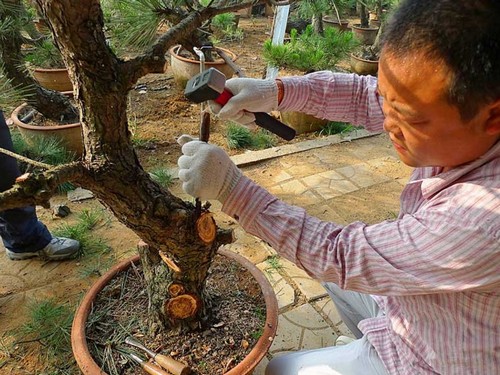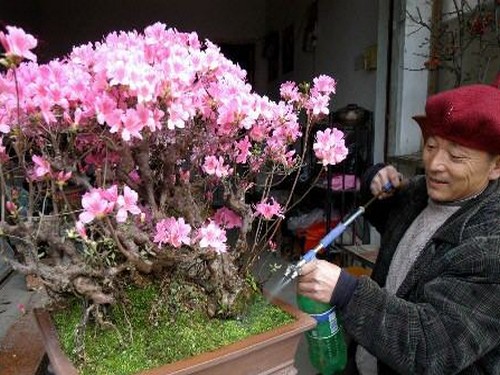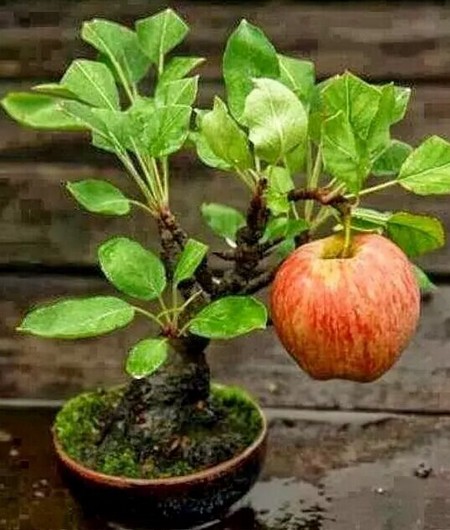How to transplant black pine bonsai
"Baizhang pine in the forest, age long Cang scale frown", this is the Song Dynasty writer Su Dongpo's poem praising the posture of the pine tree. Black pine bonsai has a strong ability to adapt to the environment, courtyard and balcony can be cultivated. Its branches spread horizontally, the crown is like an umbrella cover, the needles are dark green, the winter buds are silver-white, the trees are evergreen, and the tree posture is quaint, which can be appreciated all the year round. During the growth period, it is appropriate to put it in a sunny and well-ventilated place outside, not indoors for a long time.
The black pine pile scene, which has been cultivated for many years, is always vigorous and Qiu qu, with intertwined roots, showing the strange posture and indomitable vitality of the dragon's style, which is a good product for the family to cultivate and watch. Black pine is a positive tree, which requires sufficient light. In the growing period, especially in the period of budding and leaves, it can not be placed indoors for a long time to watch. So, how to transplant black pine bonsai?

Black pines generally grow in barren mountains and wastelands below 600 Mimi above sea level; their roots are well developed, resistant to drought and barren, and the pine bark is gray-black and scalelike, often giving people a kind of "vigorous, straight and strange" momentum. However, it is excavated and planted in a shallow basin close by, and the growth conditions are limited, so it is difficult to survive. According to the experience of some experts in black pine culture, the key to the survival of black pine lies in mining and maintenance management.
After the black pine stump is determined, it should not be excavated immediately. It should be hollowed out at the periphery of the stump root 60 cm to 80 cm, cut off part of the main root, and the incision should be flat, so as to facilitate the wound healing and promote the growth of fibrous root; and to select branches, cut short and remove buds of black pine to prevent water evaporation and turpentine spillover, fine soil can be applied to the section or wax or glue seal. The soil is then restored, watered, and maintained during the growing season. It will not be excavated until the next year.
1. The most suitable time for excavation depends on the differences between the north and the south. The temperature is generally about two degrees Celsius to seven degrees Celsius, when the black pine is in a dormant period, pine resin flows slowly, even if the root system is injured, the survival rate is still very high.
2. When digging, the soil ball should be large, do not hurt the root system as far as possible, and seal the incision with fine soil or wax at any time, and then wrap it tightly with plastic film and transport it back to planting.
3. Potting and maintenance management should be done properly:
Purple sand pottery basin is generally suitable for excavated loose piles. Before potting, remove about 1/2 of the mountain soil, cut off the withered roots, cut off some of the long roots, and cut off too many branches and pine needles to reduce the burden on the injured roots. It is best to dig more local mountain soil when mining, which is beneficial to the adaptation of black pine to the soil.
Cover the basin hole with tortoise back tiles, put the coarse-grained mountain soil at the bottom of the basin, then place the pine pile in the middle, lower 1/2 pots of soil, whichever covers the root system, compaction, and fill the soil between the root gaps with bamboo cuttings, and then go down to the soil. Never leave a hole in the root. After potting the black pine pile scene, first pour enough pond water or precipitate water, put in a sunny, moist and ventilated environment, watering should not be too much, should be dry and then watered. But keep spraying pine needles and branches with water from a spray can several times a day to keep them moist, which is good for growth.
After survival, the black pine pile should be properly buckled in spring and summer to make the new branches low and the needles short. The pruning of black pine is mainly to pick buds. The newly potted black pine pile scene generally does not pick buds within a year, and the root system is developed with luxuriant branches. The new buds elongate from March to April of the following year, but the needles have not yet been produced. Generally take off about 1/2 of the length of each top bud, if you do not need to grow the pile scene of the branches, you can pick all the terminal buds.
For the branches that affect the beautiful posture of the pile scene, they can be cut off during the winter dormancy period and sealed with wax or glue. Black pine does not like fertilizer, after survival, twice thin and rotten cake fertilizer can be applied every spring and once again in autumn.
In order to meet the needs of making bonsai, in open field cultivation, the places with sufficient light and barren soil should be selected to control the supply of water and nutrients, so that the main root is thick and short, the lateral root is developed, the stem is short and buckled, the branches and leaves are dense and clump, the posture is simple and elegant, and it can be processed in the basin if it is well formed. The trunk of the stump is thick and can be cut properly, and then the retained lateral branches are extended or drooped. When selecting the remaining lateral branches, we should pay attention to not leaving parallel branches and symmetrical branches, and it is better to have a hierarchical difference.
The posture processing of black pine should be carried out in the dormant period, when the sap flows slowly and pruning branches will not have the risk of turpentine spillover. During the growth period, you can only climb and shape, or pick buds to control growth, not pruning.
Time: 2019-05-25 Click:
- Prev

Cultivation techniques of bonsai in Yingshanhong
Yingshanhong, also known as rhododendron, belongs to the genus Rhododendron of the rhododendron family. It is an evergreen, semi-evergreen or deciduous tree and shrub. It is one of the top ten famous flowers in China. When the spring returns to the earth and the warbler cries the cuckoo, it is when the azaleas are in full bloom, and they are full of flowers, full of spring and pleasing to the eye. Main points of cultivation: 1 picking piles: although Yingshanhong varieties are common
- Next

Five characteristics of bonsai of fruit trees
Bonsai of fruit trees is the product of the combination of modern fruit tree cultivation techniques and traditional bonsai art, which integrates flower appreciation, fruit viewing and scenery viewing, so that the beauty of form and richness can be displayed at the same time. The flowers and branches are delicate and beautiful in spring, the summer is full of vitality, and the crisp fruit changes with each passing day, and the golden autumn fruit is colorful.
Related
- Fuxing push coffee new agricultural production and marketing class: lack of small-scale processing plants
- Jujube rice field leisure farm deep ploughing Yilan for five years to create a space for organic food and play
- Nongyu Farm-A trial of organic papaya for brave women with advanced technology
- Four points for attention in the prevention and control of diseases and insect pests of edible fungi
- How to add nutrient solution to Edible Fungi
- Is there any good way to control edible fungus mites?
- Open Inoculation Technology of Edible Fungi
- Is there any clever way to use fertilizer for edible fungus in winter?
- What agents are used to kill the pathogens of edible fungi in the mushroom shed?
- Rapid drying of Edible Fungi

